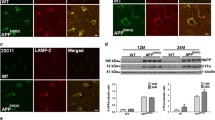Abstract
Previous experimental studies have indicated that amyloid-b peptide (Aβ) may cause axonal degeneration in the brain of individuals with Alzheimer's disease (AD) by physical injury, mass lesion, or membrane perturbation. In this study, acetylcholinesterase histochemical, and Aβ and tau immunohistochemical double-staining were performed in nondemented elderly human hippocampal and entorhinal brain samples, to demonstrate the presence of dystrophic neurites caused by the C-terminal or N-terminal fragments of Aβ. The early interactions between the Aβ-stained senile plaques (SPs) and the enzyme-positive axons were investigated. The double-stained samples revealed that Aβ deposition occurs first, followed by the development of cholinergic axonal damage. Most of the dystrophic axonal processes are incorporated in the peripheral area of the SPs and are positive for phosphorylated tau [pS202] and tau-5. The result suggests that C-terminal fragments are more harmful than N-terminal fragments of Aβ and may induce the development of dystrophic neurites by a toxic effect rather than by physical injury.
Similar content being viewed by others
REFERENCES
Braak, H. and Braak, E. 1995. Staging of Alzheimer's disease-related neurofibrillary changes. Neurobiol. Aging 16:271–278.
Kasa, P., Rakonczay, Z., and Gulya, K. 1997. The cholinergic system in Alzheimer's disease. Prog. Neurobiol. 52:511–535.
Pike, C. J., Cumming, B. J., and Cotman, C. W. 1992. β-Amyloid induces neuritic dystrophy in vitro: Similarities with Alzheimer pathology. Neuroreport 3:769–772.
Kasa, P., Papp, H., Kovacs, I., Forgon, M., Penke, B., and Yamaguchi, H. 2000. Human amyloid-β1–42 applied in vivo inhibits the fast axonal transport of proteins in the sciatic nerve of rat. Neurosci. Lett. 278:117–119.
Vickers, J. C., Dickson, T. C., Adlard, P. A., Saunders, H. L., King, C. E., and McCormack, G. 2000. The cause of neuronal degeneration in Alzheimer's disease. Prog. Neurobiol. 60:139–165.
Casanova, M. F., Hill, W. D., and Pourdihimi, B. 2001. Senile plaques exert no mass lesion effect on surrounding neurons. J. Neurosci. Meth. 110:125–133.
Knowles, R. B., Wyart, C., Buldyrev, S. V., Cruz, L., Urbanc, B., Hasselmo, M. E., Stanley, H. E., and Hyman B. T. 1999. Plaque-induced neurite abnormalities: Implications for disruption of neural networks in Alzheimer's disease. Proc. Natl. Acad. Sci. USA 96:5274–5279.
Kanfer, J. N., Sorrentino, G., and Sitar, D. S. 1999. Amyloid beta peptide membrane perturbation is the basis for its biological effects. Neurochem. Res. 24:1621–1630.
Larner, A. J. 1999. Hypothesis: amyloid β-peptides truncated at the N-terminus contribute to the pathogenesis of Alzheimer's disease. Neurobiol. Aging 20:65–69.
Geddes, J. W., Tekirian, T. L., Mattson, M. P. 1999. N-Terminus truncated β-amyloid peptides and C-terminus truncated secreted forms of amyloid precursor protein: Distinct roles in the pathogenesis of Alzheimer's disease. Neurobiol. Aging 20:75–79.
Markesbery, W. R. 1997. Neuropathological criteria for the diagnosis of Alzheimer's disease. Neurobiol. Aging 18:S13–S19.
Tago, H., Kimura, H., and Maeda, T. 1986. Visualization of detailed acetylcholinesterase fiber and neuron staining in rat brain by a sensitive histochemical procedure. J. Histochem. Cytochem. 34:1431–1438.
Kasa, P., Papp, H., Kasa, P., Jr., and Torok, I. 2000. Donepezil dose-dependently inhibits acetylcholinesterase activity in various areas and in the presynaptic cholinergic and the postsynaptic cholinoceptive enzyme-positive structures in the human and rat brain. Neuroscience 101:89–100.
Barelli, H., Lebeau, A., Vizzavona, J., Delaere, P., Chevallier, N., Drouot, C., Marambaud, P., Ancolio, K., Buxbaum, J. D., Khorkova, O., Heroux, J., Sahasrabudhe, S., Martine, J., Warter, J.-M., Mohr, M., and Checler, F. 1997. Characterization of new polyclonal antibodies specific for 40 and 42 amino acid-long amyloid β peptides: Their use to examine the cell biology of presenilins and the immunohistochemistry of sporadic Alzheimer's disease and cerebral amyloid angiopathy cases. Mol. Med. 3:695–707.
Benzing, W. C., Brady, D. R., Mufson, E. J., and Armstrong, D. M. 1993. Evidence that transmitter-containing dystrophic neurites precede those containing paired helical filaments within senile plaques in the entorhinal cortex of nondemented elderly and Alzheimer's disease patients. Brain Res. 619:55–68.
Su, J. H., Cummings, B. J., and Cotman, C. W. 1994. Early phosphorylation of tau in Alzheimer's disease occurs at Ser-202 and is preferentially located within neurites. Neuroreport 5:2358–2362.
Su, J. H., Cummings, B. J., and Cotman, C. W. 1996. Plaque biogenesis in brain aging and Alzheimer's disease: I. Progressive changes in phosphorylation states of paired helical filaments and neurofilaments. Brain Res. 739:79–87.
Beach, T. G., Honer, W. G., and Hughes, L. H. 1997. Cholinergic fiber loss associated with diffuse plaques in the non-demented elderly: the preclinical stage of Alzheimer's disease? Acta Neuropathol. 93:146–153.
Yasuhara, O., Kawamata, T., Aimi, Y., McGeer, E. G., and McGeer, P. L. 1994. Two types of dystrophic neurites in senile plaques of Alzheimer disease and elderly nondemented cases. Neurosci. Lett. 171:73–76.
Pillot, T., Drouet, B., Queille, S., Labeur, C., Vandekerchkhove, J., Rosseneu, M., Pincon-Raymond, M., and Chambaz, J. 1999. The nonfibrillar amyloid β-peptide induces apoptotic neuronal cell death: Involvement of its C-terminal fusogenic domain. J. Neurochem. 73:1626–1634.
McKee, A. C., Kosik, K. S., and Kowall, N. W. 1991. Neuritic pathology and dementia in Alzheimer's disease. Ann. Neurol. 30:156–165.
Vickers, J. C., Chin, D., Edwards, A. M., Sampson, V., Harper, C., and Morrison, J. 1996. Dystrophic neurite formation associated with age-related β-amyloid deposition in the neocortex: Clues to the genesis of neurofibrillary pathology. Exp. Neurol. 141:1–11.
Ferreira, A., Lu, Q., Orecchio, L., Kosik, K. S. 1997. Selective phosphorylation of adult tau isoforms in mature hippocampal neurons exposed to fibrillar Aβ. Mol. Cell Neurosci. 9:220–234.
Busciglio, J., Lorenzo, A., Yeh, J., Yankner, B. A. β-Amyloid fibrils induce tau phosphorylation and loss of microtubule binding. Neuron 14:879–888.
Lee, V. M. 1996. Regulation of tau phosphorylation in Alzheimer's disease. 777:107–113.
Author information
Authors and Affiliations
Rights and permissions
About this article
Cite this article
Kasa, P., Papp, H., Zombori, J. et al. C-Terminal Fragments of Amyloid-β Peptide Cause Cholinergic Axonal Degeneration by a Toxic Effect Rather Than by Physical Injury in the Nondemented Human Brain. Neurochem Res 28, 493–498 (2003). https://doi.org/10.1023/A:1022813104905
Issue Date:
DOI: https://doi.org/10.1023/A:1022813104905




